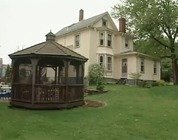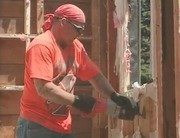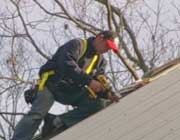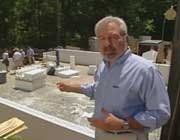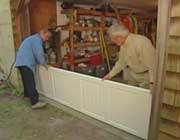Once we had a roof over our heads, we could get tight to the weather installing our windows and our sliding patio door in the back.
And these are low-E glass windows.
They're a new fiberglass window from Pella that includes low-E emissivity glass.
Which means that they fit right into our energy conservation story.
Plus, the fiberglass frames, you know, they're not susceptible to extremes of weather, heat, or cold.
They're not going to warp or rot or anything like that.
This is our Pella Impervia patio door.
It's made from Dura-Cast, a fiberglass composite.
A very strong material, a very durable material.
Resistant to impact, to scratches and just a very, very low maintenance material for windows and doors.
Another feature I want to show you on our product is all of our hardware is color matched to the product.
So it blends very, very nicely for the interior look.
And as an upgrade option, it's also available in other finishes, like brass, satin nickel, or oiled bronze.The
other feature of the double hung obviously is the dual operation of the sash.
So, the lower sash raises, the upper sash lowers for very natural ventilation.
And then the other feature we have is an easy tilt clean feature.
So, it's easy to tilt both sash and clean the exterior and the interior from the inside of the home, so you are safe.
So, you don't have to get on any ladders, and then they simply snap back in place, and you can close the window.
The other feature of Impervia is the Energy Star rating.
Pella Impervia products are Energy Star rated in all fifty states, saving the average home owner 24 percent over single pane wood windows.
And the powder coat finish over the fiber glass means that you don't have to worry about staining or putting a finish on it.
You can use them right like they are.
I also like the very slim profile and the fact that you get full screens on them.
But anyway, once the windows are all in place in the construction site, that means we're into the weather and we can start worrying drying out the inside of the job.
And that's become more and more of an concern for builders all over the country because of mold growth problems, within the house, as it's being built.
We brought in the pros to show us how it's best done.
My name is Curt Bolden, I'm with the Hydro Lab Training Facility.
Training research is what we do for water damage mitigation, new construction drawing.
We train mainly insurance risk, or insurance companies and restoration contractors.
We do property management and also contractors.
Our goal is to basically educate them on the effects of water damage to a structure .
Whether it be from a broken pipe, a hurricane, or just new construction.
New construction is a big problem in our industry right now because a lot of the materials that are to be delivered to the job sites are wet, a lot of people don't know how wet they are.
This is an example of a new construction.
It has been wet, as of up to a week and a half ago.
It appears to be dry and a lot of contractors at this point would go ahead and start putting in their insulation, hanging the wallboard.
What they don't know, though, is what the moisture content load is in the structure.
Obviously moisture being one of the number one causes of defect in a home or in a commercial structure.
We need to map this structure out showing them how much moisture is in all these different building materials.
At that point, we dry.
This being one method, we actually install long pins or screws.
I can show you how we do this.
Alright, once we install the screws, we've actually, we've actually taken a pin or a screw and we put it through this mass of material.
The purpose of that is now we can check the moisture content in the core of this entire piece of wood.
What we do now is we're gonna actually use what is called a Delmhorst meter.
This particular meter basically reads moisture content from these two pins.
I'll demonstrate here as you can see the moisture content on my finger.
So, it gives you a reading of what the moisture content load using electrical current.
The pins or the screws that we install into the wall are basically extensions off of these pins.
So at this point a surface reading, for example, on this piece of wood shows that this wood is dry.
If that's as deep as you use this meter, then you're not getting an accurate reading.
Once you actually take the pins and put them on the screws, you can see that the moisture content load of this particular mass of lumber is running about 18 percent.
Industry standard in this region is about 12 percent this time of year.
A number that's very dangerous is the 16 percent moisture content load which is basically where you get fungal growth, where you get a mold growth.
So, if you were to trap this lumber behind drywall and insulation, there's no way for it to dry.
Obviously leads to a possibility of having fungal growth in the wall structure.
Inside the building, we're creating an atmosphere which is going to promote the rapid evaporation of the bound water inside of the building materials.
As we bring very dry and warm air into the building and circulate it through the building, the wood will give up its moisture.
That moisture will become part of the air.
We will take that air, and bring it back out of the building.
Basically, what this equipment is doing is it's turning the inside atmosphere into a huge sponge that can absorb tremendous amounts of water .
Once that water is absorbed into that dry air stream, we remove it directly to the outside.
So the building dries very, very quickly and there is no odors left behind.
Equipment that you are looking at were a trailer and there are about 200 of them around the country presently.
Our typical project is drying flooded buildings from all sorts of mishaps.
Anything from a hurricane to a pipe break, ice machine.
This trailer is designed to create an environment inside of a building that will evaporate the excess moisture, bring it to the outside.
Keep bringing dry clean air in, taking wet moist air out.
Taking air with odors to the outside.
It will dry a building incredibly fast, whether is happens to be a hurricane, or just in this particular case, bow moisture to new building materials.
